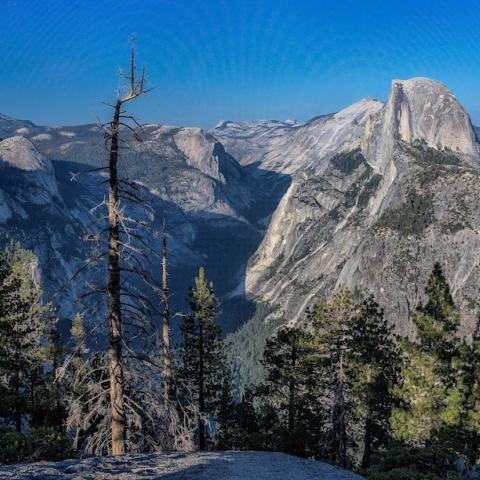Editor's note: The following advertiser-supported content is from Traveler's Essential Park Guide for Spring 2018.
As iconic as Yosemite National Park can seem, it changes greatly depending upon the seasons. From snow to water to fall colors, it’s always changing; any season is a good time to visit.
Spring Waterfalls
As the days lengthen and winter loosens its grip, the high country’s snowpack melts and feeds the creeks, streams, rivers and waterfalls in Yosemite. This makes for great waterfall watching from May through the middle of summer.
While some waterfalls are hidden and tiny, others are stunning spectacles. The most notable is Yosemite Fall, which drops 2,425 feet from the top of the Upper Falls to the bottom of the Lower Falls. The native people, the Ahwahneechee, called this incredible torrent Cholock, and believed the pool at the base was the home to spirits and witches.
An easy walk is the one-mile loop trail to the base where you can listen to the thundering water and feel the spray. You can hike to the top of the falls, but it’s more than seven miles of steep trail, with an elevation gain of 2,700 feet.
Sentinel Fall drops around 2,000 feet on the south side of the Yosemite Valley, cascading from ledge to ledge to ledge, with peak flows in May. And there are many others: Ribbon Falls at 1,612 feet, Horsetail Fall at 1,000 feet, and Bridalveil Fall, which drops 620 feet and greets visitors from the Wawona Road.
Trails can be muddy and snow-covered, but late in spring head up the Mist Trail to Vernal Fall (317 feet) and on another 2 miles towards Nevada Fall (594 feet). Take a raincoat and good boots; you will get wet. Spend time at the brink of both of these falls for a great view down the valley, but watch your step, and never enter the water above a fall. Peak flows are in late May.

When summer’s heat kicks in, the Mist Trail is the place to cool off/NPS
Summer Hikes
Summer is a perfect time to escape the valley heat and crowds and tramp around the spectacular mountains of Yosemite National Park as John Muir did.
In this wilderness unlike any other, granite domes soar above you, birds make their shrill calls, and forests fill the soul. You can leave the Yosemite Valley and break a sweat by heading up, up, up into the canyons via their trails. Better yet, visit the high country for an easier romp in the high alpine meadows with towering peaks soaring high overhead.
While some hikes require a permit because of their popularity, most are open and ready for your best hiking shoes. Make sure you take some water, map, a raincoat, and a snack; you’ll probably need all three. Keep an eye on the skies for gathering storms and lightning, and stay away from the high peaks.

Trails, including the iconic John Muir Trail, head out from Tuolumne Meadows/Kurt Repanshek
Autumn Splendor
Summer was on the run in Yosemite. A few flakes began to fall in late August on the highest peaks in the Sierra Nevada range; a dusting that foretold of the change of seasons. Once-green meadows were now gold, with red and orange shrubs scattered throughout the high country. Down in the valley the crowds were thinning as the temperatures dropped and kids headed back to schools.
Autumn is a wonderful time in Yosemite. Colder temperatures mean no more bugs, the days are warm and the nights are chilly. Ice sheets rimming lakes reflect the towering walls that wrap the valley floor.
It’s a busy time for wildlife, too. They’re busy finding food for the coldest months, storing it underground or in layers of fat under their fur. Deer are caught up in the yearly mating dance of clattering antlers as they try to impress the females.
Take a hike up to Vernal and Nevada falls for a great view down into the valley, before retiring to a roaring fire in your lodging. The days shorten, so it’s important to get an early start too.

Winter offers miles of ski and snowshoe trails/NPS
Winter Snows
By January the white mantle has engulfed the Sierra Nevada and Yosemite National Park, but this isn’t the season to stay indoors. It reveals another, deeper, dimension in the park. You’re likely to see animals, or at least their tracks, which you wouldn’t when the ground is bare of snow. There’s more solitude and quiet too.
While the Tioga Road that runs through Tuolumne Meadows closes to wheeled traffic with the deep snows, some hardy souls cross-country ski or snowshoe into the high country. Other skiers head up towards Glacier Point and the Yosemite Ski & Snowboard Area, formerly called Badger Pass Ski Area.
There’s also a tubing area and terrain park here, and the access to the backcountry and cross-country ski trails is superb, with 90 miles of marked snowshoe and cross-country ski trails and 10.5 miles of groomed skating track.
You could spend the day on a self-guided snowshoe hike in Aspen Grove. Two overnight huts are accessible from the ski area for the more adventurous.
Ski or snowshoe in awe beneath the giant sequoia trees in the Tuolumne or Mariposa groves. Watch for the tracks of snowy denizens of the forest, or take a heart-pounding skate-ski up a road until the valley vista presents itself. These are some of the grandest trees on Earth, and it’s a whole different world in the winter.
As you can see, anytime is a good time to visit Yosemite. It will feed your soul and wear down your soles.






 Support Essential Coverage of Essential Places
Support Essential Coverage of Essential Places






